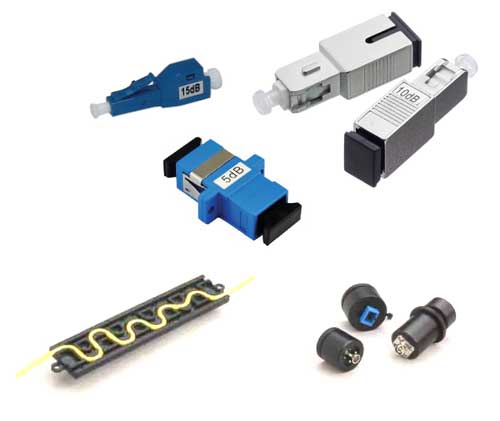Fiber
Optic Attenuator MiniCourse
Fiber
U MiniCourses are courses on a specific topic that you can
take in about an hour or less. They are based on questions
people ask FOA all the time, so the topics are recommended
by our readers.
Level: Intermediate
Intended For:
Designers
of fiber optic communications networks
Users
of fiber optic communications networks
Contractors and techs who install, operate and maintain
them.
Objectives:
From this self-study program you should learn:
All fiber optic datalinks require the proper optical power level at the receiver.
High power levels can be adjusted using attenuators
How to choose the proper attenuator for a datalink
How to test the attenuated link to ensure proper operation
- Prerequisites

When
you finish, you can take an online test on this course to
qualify for a "Fiber U Certificate of Completion." The
test cost for a Fiber U MiniCourse is $10US.
Introduction
Most of
our attention in a data link focuses on the cable plant, particularly
minimizing the loss of the installed cable plant. However many fiber optic links
have too much power at the receiver, a consequence of having links
designed for long distances being used at shorter distances.
This course will discuss the need for attenuators, how to determine the
value of attenuator needed and how to install and test them in the
link.
Assignments
For
this lesson plan you will be instructed to watch the
video, read
the reference
and take a quiz (Test Your Knowledge) to complete the
course. If you are
unfamiliar with datalinks and there performance parameters, begin with the FOA Guide page on datalinks.
Lesson
Plans
Watch
the videos, read the section in the FOA Guide and take
the quiz. For this course, we recommend watching the
videos first and then reading the FOA Guide page. There is a short quiz linked below you can use to test
your comprehension. The Fiber U Certificate of Completion test
is based on these references.
Note: You will need a basic understanding of how fiber optic datalinks work. Refer to the FOA Guide page on datalinks.
and the video FOA Lecture 27 Fiber Optic Datalinks.
Videos
FOA Lecture 71 Fiber Optic Attenuators
FOA Guide
Using Attenuators With Fiber Optic Data Links
Test Your Comprehension
Fiber Optic Attenuators Quiz.

When
you finish all the assignments you can take an online test
on this course to qualify for a "Fiber U Certificate of
Completion." The test cost is $10US.
Go here to take the Fiber U Attenuators MiniCourse
Certificate of Completion test. Here
are detail directions if this is your first time
taking a Fiber
U Certificate of Completion exam.
This information is
provided by The Fiber Optic Association, Inc. as a
benefit to those interested in teaching, designing,
manufacturing, selling, installing or using fiber optic
communications systems or networks. It is intended to be
used as an overview and/or basic guidelines and in no
way should be considered to be complete or
comprehensive. These guidelines are strictly the opinion
of the FOA and the reader is expected to use them as a
basis for learning, as a reference and for creating
their own documentation, project specifications, etc.
Those working with fiber optics in the classroom,
laboratory or field should follow all safety rules
carefully. The FOA assumes no liability for the use of
any of this material.
|



